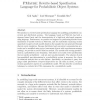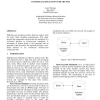TOMACS
1998
14 years 6 months ago
1998
architectures at multiple levels of abstraction, encompassing both hardware and software. It has five modes of operation (Design, Model Validation, Build Simulation, Simulate Syste...
EWC
2007
14 years 7 months ago
2007
This paper presents research that led to the design and implementation of fast and interactive collision detection methods that can be used to identify and report undesirable con�...
ENTCS
2006
14 years 7 months ago
2006
We introduce a rewrite-based specification language for modelling probabilistic concurrent and distributed systems. The language, based on PMaude, has both a rigorous formal basis...
HPDC
2010
IEEE
14 years 8 months ago
2010
IEEE
This paper proposes a cache hierarchy that enables Web search engines to efficiently process user queries. The different caches in the hierarchy are used to store pieces of data w...
WSC
1997
14 years 8 months ago
1997
The Enterprise Modeling Framework (EMF) consists of a methodology for modeling the three major facets of an enterprise, viz., function, information and dynamics. Its main goal is ...
WSC
1997
14 years 8 months ago
1997
Discrete-event simulation models typically have stochastic components that mimic the probabilistic nature of the system under consideration. Successful input modeling requires a c...
WSC
2000
14 years 8 months ago
2000
This paper describes how discrete-event simulation enhanced a traditional process design effort for a new media company in pre-launch mode. Because the company's business mod...
WSC
1998
14 years 8 months ago
1998
Modeling and simulation provide objective analysis tools for many fields including manufacturing. This paper presents the requirements and describes the usefulness of a web-based ...
WSC
1998
14 years 8 months ago
1998
Most discrete-event simulation models have stochastic elements that mimic the probabilistic nature of the system under consideration. A close match between the input model and the...
ISTA
2007
14 years 8 months ago
2007
: Today, discrete-event simulation (DES) use in the manufacturing industry has become widespread, but far from all companies use this technology.Often simulation is used on a `one-...






